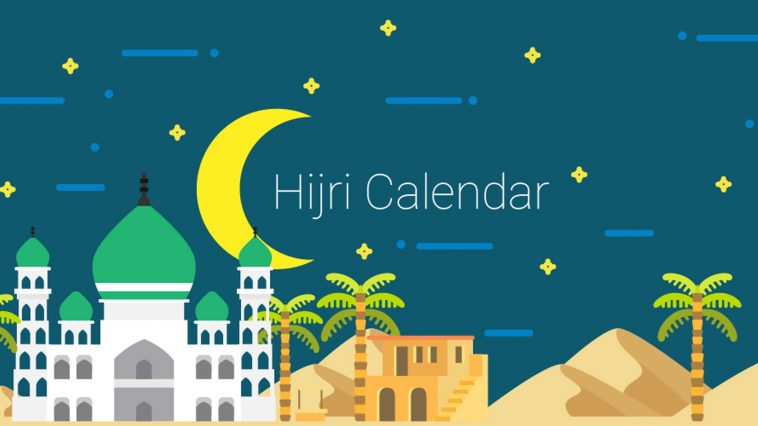There appears not to be a single website today that provides a simple and clear explanation as to what the real purpose of the Islamic calendar (Hijri) is;
Why it is important to Muslims; how is it relevant; and how best to explain this to young children and teenagers, in order to help them develop a sense of identity with the Hijri.
With Ramadan a few short days away, we too often privately wonder if it was better and easier if we had a fixed date every year to start and end fasting but this is precisely where the ingenuity of the Islamic Hijri calendar lies.
The Islamic calendar (Hijri) is 10-11 days shorter than the normal calendar (Gregorian) we are used to, which means Ramadan starts 10-11 days early each year.
This in turn means we Muslims get to experience Ramadan under all seasons and climates, one of several key reasons why we Muslims have to fast in order to relate to the experience of what it is like for the millions of poor people around the world who do not have food and water for days or weeks.
Yet we get to eat at the end of everyday so that we can at the very least learn to appreciate what we have. This is perhaps one of the biggest ingenuity of the Islamic Hijri calendar.
BACKGROUND
In 637 CE (approximately 1400 years ago), sixteen to eighteen years after the Hijrah (migration) of the Prophet Muhammad (peace be upon him), the Caliph Umar Ibn Al-Khattab (may Allah be pleased with him) put in place the new Islamic year marking the month our beloved Prophet Muhammad (peace be upon him) migrated from Makkah to Madina, to escape being attacked by a certain group of hate-mongering people in control of Makkah, who were disturbed by the growing appeal of Islam to the people in Madina.
Al-Bukhaari narrated in his Saheeh (3934) that Sahl ibn Sa‘d said: They did not start the calendar from the beginning of the Prophet’s mission or from his death; they only started it from the time of his arrival in Madinah.
We are now (2018) in the [1439th] year since that momentous event occurred. In other words, it has been 1,439 + 16 years since the migration, marked with the introduction of the Islamic calendar, known as Hijri.
The Islamic calendar (Hijri) however is not just about migration but instead is about aiming for a better next day. It is about striving i.e., trying your best – to change your circumstances in order to become a better person.
It started when Prophet Muhummad (peace be upon him) began his journey from Makkah to Madinah. This, in essence is where it all began.
Therefore, it may be possible to define the meaning of Hijrah as a way to seek a better life away from a life that may not be physically that much more comfortable but spiritually uplifting, as the Prophet (peace be upon him) and his companions did.
Migration however did not mean to cut yourself out from the world to seek a better life. On the contrary:
“[Migration or] Exile, since it implied uprooting oneself while remaining faithful to the same God, to the same meaning, in different environments…
In effect, exile was also to require that the first Muslims learn [to live among] the influential presence of the Jewish and Christian communities in Madina, which was something new to Muslims.”
(Source: The Messenger – The meaning of the Life of Muhammad by Tariq Ramadhan)
Not only did the Hijri (migration) lead to the exposure to a different set of culture and people, we learn from the example of Prophet Muhammad (peace be upon him) and those that migrated with him to integrate into the new society in Madinah by setting a good example of themselves when living among the Jews, Christians, other followers of faith or non-belivers, which within a short span of eight years won them alot of respect not only within Madinah but across the Arabian Peninsula.
The act of migration itself also replicated the footsteps of Prophet Musa (peace be upon him) as well as our Jewish cousins who successfully escaped the rule of Fir’aun (Pharaoh) after miraculously crossing the Red Sea and surviving the perilous journey to the promised land.
“Moses [too] had liberated his people from Pharaoh’s oppression and led them toward faith and freedom.
The essence of Hijrah is of exactly the same nature: persecuted because of their beliefs, the faithful decided to break away from their tormentors and march to freedom. In so doing, they stressed that they could not accept oppression, that they could not accept the status of victim.”
(Source: The Messenger – The meaning of the Life of Muhammad by Tariq Ramadhan)
WHAT IS THE PURPOSE OF THE ISLAMIC CALENDAR?
While the basic purpose of the Hijri calendar is to help Muslims worship. For example, when is the start and end of Ramadhan, the two Eids and other important events from the life of Prophet Muhammad (peace be upon him), following the calendar is not just an act of worship itself.
Instead, it is worth asking: How else could one mark certain important dates in Islamic history (for e.g., dates listed above) if we relied completely on the Gregorian calendar? Answer: we can’t. This is perhaps the greatest use of the Islamic Hijri calendar is based on the position of the moon.
Granted – and although the Islamic calendar today has little or no use to a farmer or anyone working for a hotel or airline as the calendar is not linked with seasonal or weather changes (i.e. spring, summer, winter, autumn)., the lunar calendar did however have its uses for Muslims and non-Muslims that were born a thousand years before us i.e., before Allah blessed mankind with electricity, lamps, compass, maps and the like.
For example during full moon, the skies lit up better at night and when it was weak, the stars shine better for scholars, star gazers, and travellers, etc.,. Therefore there was a time in history when the lunar calendar was much more practical than the Gregorian calendar.
WHY COULDN’T WE HAVE STUCK TO THE GREGORIAN CALENDER FROM THE START?
To answer this question in a nutshell, the Gregorian calendar in its current form did not exist then.
The calendar we use today has gone through a large number of changes starting with the Roman Emperor Julius Caesar, 46 years before the birth of Prophet Isa (peace be upon him) – or since over 2,000 years ago from today, as of year 2018
The reason for the several changes was because the calendar then was changed according to the whims of whoever was in power and less on a universally agreed system, over the last 2000-year period.
Depending on who was in power, additional number of days were added to a given month or up to 10 or more days were taken out altogether from a given month. After going through several changes, the Gregorian calendar is finally today what it is.
If Muslims and the Companions of the Prophet (who were born approximately 600 years after the initial introduction of what was also then known as the Gregorian calendar) had used a defective dating system for recording historic events, it will surely have led to confusion.
Meanwhile, the lunar calendar, based on the natural orbit of the moon around earth is as accurate as a dating system can be.
When there was no technological means of calculating the exact time and date of the appearance of the moon available to people, the only alternative was to physically observe it.
Today with technology, the same result can be achieved with perhaps a bit more accuracy and yet without technology, we are still able to physically observe the moon the way our ancestors have been doing for centuries,
making the lunar calendar relatively more error-free and as such the most reliable tool of time measurement in dates, months, years and centuries.
In other words, in the history of the lunar calendar, it has always been accessible to everyone, layman or man of science, as the outcome is the same.
Therefore, all praise is for Allah alone for guiding Muslims with an alternative way of marking dates and letting us experience Ramadan throughout the years under all climatic conditions.



